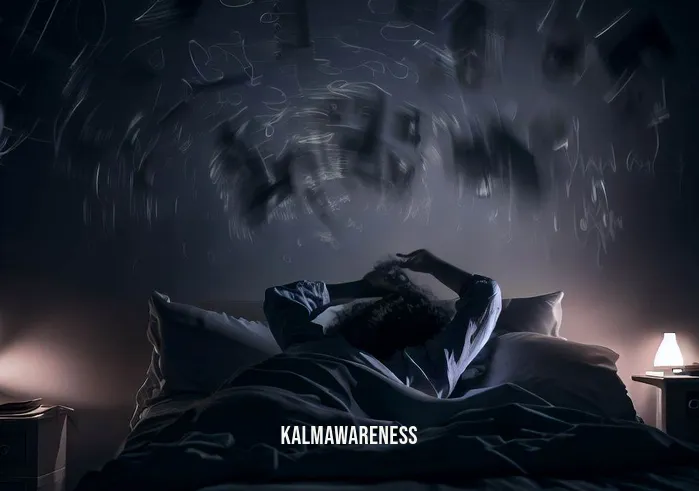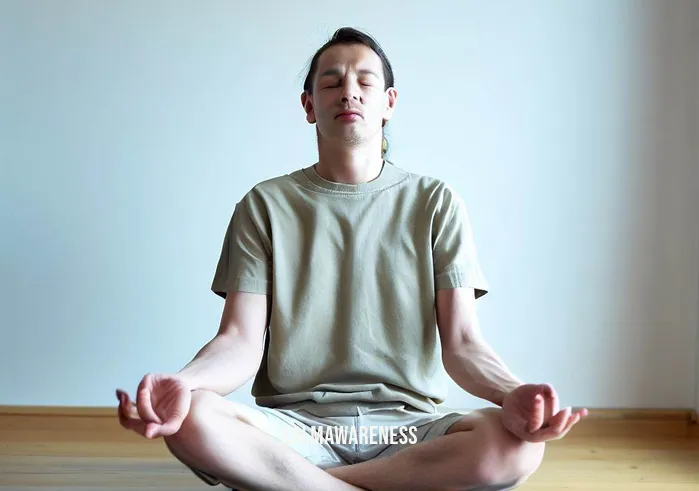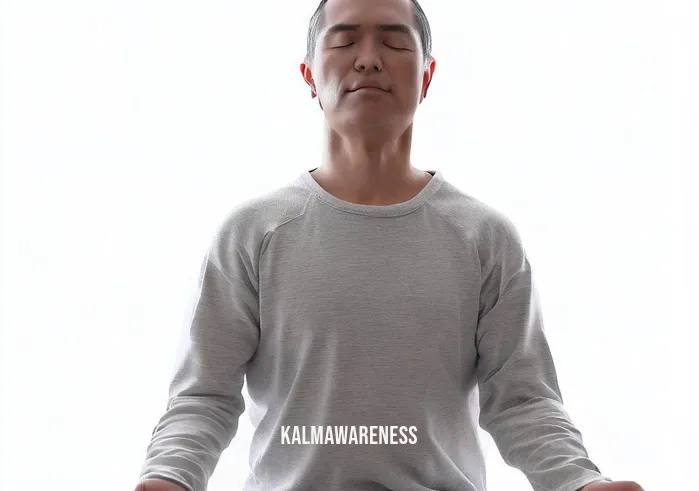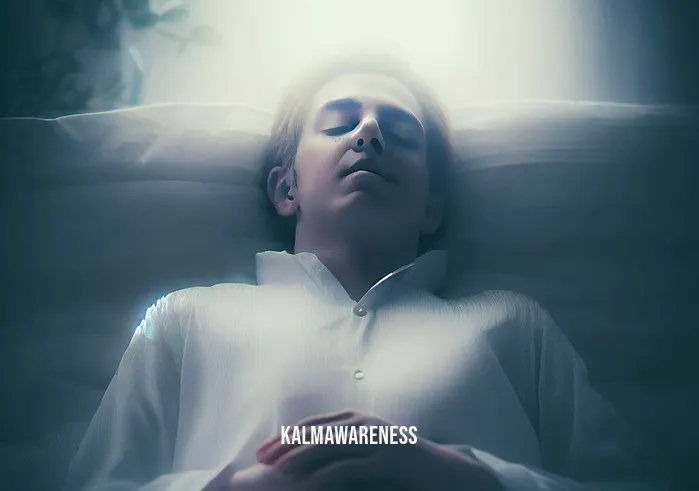Can You Meditate While Sleeping? The Intersection of Sleep and Mindfulness
The age-old pursuit of restful sleep and the relatively recent cultural spotlight on mindfulness might seem worlds apart. However, the burning question “Can you meditate while sleeping?” intriguingly brings these two areas into a singular focus. Meditation and sleep are both essential elements of well-being, serving as restorative practices that offer respite from the stressors of daily life. Yet, their convergence presents a nuanced landscape that is rich with both potential and pitfalls.
The Conventional Wisdom: Sleep and Mindfulness as Separate Entities
Before diving into the intertwining threads of sleep and meditation, it’s crucial to understand each one in its isolated form.
Understanding Sleep
Sleep is an unconscious state, a period of rest that allows our bodies and minds to recharge, heal, and build energy for the day ahead. When you are deep into sleep, your brain goes through specific cycles, including REM (Rapid Eye Movement) and NREM (Non-Rapid Eye Movement) sleep. These cycles are critical for memory consolidation, physical recovery, and emotional stability.
The Power of Mindfulness
On the other side, mindfulness is a conscious effort to be completely present and fully engage with the here and now. It’s a skill often honed through specific practices like Mindful Movement and Mindful Hypnobirthing, aimed at creating a state of heightened awareness. Mindfulness practices encourage active engagement with one’s thoughts, emotions, and physical sensations.
“Mindfulness involves attaining a peaceful state of mind in which thoughts are not occupied by worry.” — Source
The Paradox: Unconscious Rest vs Conscious Awareness
One might argue that sleep and mindfulness appear to be on opposite ends of the consciousness spectrum. Sleep is largely an unconscious process. Whether you are a fan of a 15-minute power nap or a solid 8-hour sleep, once you drift off, you relinquish control over your conscious mind.
On the other hand, mindfulness is all about control and awareness. It often involves specific breathing techniques and requires one’s full attention to the present moment. So, the question becomes even more intriguing: Can you navigate these seemingly conflicting states to achieve both restful sleep and mindful awareness?
Exploring Middle Ground: Lying-Down Meditation
There are forms of meditation that may serve as a bridge between these contrasting states. One such method to explore is lying-down meditation. This technique allows you to rest your body while keeping your mind alert. It is a balanced practice that may act as a precursor to sleeping meditation.
What’s Ahead
Navigating the juncture of sleep and mindfulness is an exciting realm of discovery that promises benefits for both mental and physical well-being. But, as is the case with all complex subjects, there are caveats and considerations to keep in mind. From understanding the judgment of the wise in ancient meditation practices to exploring modern approaches like Rouse Yoga, there’s a wealth of information to delve into.
In the next chapter, we will explore specific techniques that aim to meld sleep and mindfulness into a harmonious practice. You will learn how to apply mindful strategies to induce a state of restful alertness, preparing you for the potential of meditative sleep. We will also tackle the science behind this fascinating intersection and what experts have to say about its efficacy. So, continue reading to discover whether the question “Can you meditate while sleeping?” is a paradox or a gateway to unprecedented rest and awareness.

Techniques and Benefits: Unveiling the Mysteries of Meditating While Asleep
After laying the groundwork for understanding the relationship between sleep and mindfulness in the previous chapter, it’s time to dive into the nitty-gritty of the techniques and benefits related to our central question: can you meditate while sleeping? This concept is not just a novel idea, but a burgeoning field that opens up new avenues for rest and rejuvenation.
Techniques: Bridging the Gap Between Sleep and Meditation
It’s crucial to approach this practice with intention. The following techniques offer ways to explore the realm of sleeping meditation, encouraging both rest and awareness.
Breathing Techniques
Different meditation practices emphasize various breathing techniques that you can integrate into your pre-sleep routine:
- Deep Breathing: Inhale deeply, filling your lungs completely, and exhale fully.
- Box Breathing: Inhale, hold, exhale, and hold again for the same duration.
Walking Meditation
For those who want a more active form of meditation, walking meditation can be particularly effective before bed. It’s a way to engage your body while calming your mind.
Mirror Gazing
Although unconventional, mirror gazing has spiritual benefits that can be deeply introspective and can prepare you for mindful sleep.
Benefits: More than Just Rest
| Benefit | How It Works | Related Technique |
|---|---|---|
| Enhanced Dream Recall | Keeps the mind in a state of awareness even during sleep | Deep Breathing |
| Emotional Stability | Helps process emotions during the sleep cycle | Walking Meditation |
| Lower Stress Levels | Alleviates stress through deep relaxation | Box Breathing |
| Improved Physical Health | Encourages better sleep quality, leading to physical wellness | Deep Breathing |
| Cognitive Clarity | Facilitates better mental clarity through dream work | Mirror Gazing |
Mindfulness Across Different Life Stages
It’s important to note that the concept of meditating while asleep isn’t limited to a specific age group. For instance, teenagers are increasingly embracing walking meditation to improve their focus and manage stress. Older adults, too, can benefit from these practices to improve sleep quality and overall well-being.
Maintaining Consistency: It’s All in the Mind
When it comes to practicing sleeping meditation, keeping the practice consistent is crucial. The mind is a complex tool, but you can train it to be stronger than your feelings. This will help you attain the required balance of rest and awareness in the long run.
Concluding Thoughts: What’s Ahead?
The concept of meditating while asleep opens up numerous possibilities for holistic wellness. As you’ve seen, there are techniques you can try, each with its set of benefits, to make the dream of meditating while sleeping a reality. But is there scientific backing for these techniques? What do experts in the field of mindfulness and sleep science have to say?
In the next chapter, we’ll delve into the science behind meditating while asleep. We’ll explore research studies, expert opinions, and will even debunk some myths surrounding this concept. So, continue reading to uncover the science that could potentially revolutionize the way you think about sleep and mindfulness.

The Inspirational Journey: Unearthing Hope in the Practice of Meditating While Asleep
Having explored the techniques and benefits in the last segment, let’s now turn our attention to the transformative power of inspiration when it comes to meditating while sleeping. As the saying goes, “Where there is hope, there is a way,” and this chapter aims to ignite that hope. We’ll delve into words of wisdom that inspire, and discover how these intersect with our central query: can you meditate while sleeping?
How Inspiration Fuels the Practice
Inspiration acts as the wind beneath the wings of any new endeavor, and meditative sleep is no exception. When you’re inspired, you’re more likely to be consistent and keep the practice in mind.
“Hope is being able to see that there is light despite all of the darkness.” — Desmond Tutu
Drawing inspiration from these words, we can begin to see how this blend of sleep and mindfulness can shine a light on the darker areas of our emotional and psychological landscape.
Icons in Mindfulness and Their Thoughts on Sleeping Meditation
Many renowned thinkers have pondered over the intersect of sleep and mindfulness, although not always under the label of “meditating while asleep.”
“To sleep, perchance to dream – ay, there’s the rub.” — William Shakespeare
Shakespeare’s classic line from Hamlet alludes to the complex relationship between sleep and the mind. Perhaps, if he were alive today, he would have been intrigued by the idea of maintaining awareness through sleeping meditation.
In more contemporary times, teachers like Jack Kornfield have written on meditation for beginners, setting the stage for inclusive practices that could include meditating while asleep.
“The best way to capture moments is to pay attention. This is how we cultivate mindfulness.” — Jon Kabat-Zinn
Applying Kabat-Zinn’s perspective to sleeping meditation, it’s possible to capture the fleeting moments of semi-consciousness that dance on the edge of sleep and wakefulness.
The Power of Sustainable Practices
“Sustainability is no longer about doing less harm. It’s about doing more good.” — Jochen Zeitz
This quote, although generally aimed at environmental sustainability, has enormous relevance to sustainable self-care practices. If meditating while sleeping could be refined into a sustainable practice, it offers not just less harm (in terms of less stress, better mental health), but more good (improved sleep quality, emotional balance).
The Ripple Effects: How We Get Deep So Fast
While meditating while asleep might sound like a complex endeavor, the process to achieve this depth quickly is surprisingly straightforward. This simplicity is inspirational in itself, promising an accessible entry point into a state of higher awareness and restful sleep.
“A journey of a thousand miles begins with a single step.” — Lao Tzu
Lao Tzu’s wisdom reinforces the idea that the transformative journey of meditating while asleep is open to anyone willing to take that first step.
Up Next: The Scientific Lens
With a heart full of inspiration and hope, the question still stands: Is there empirical evidence supporting the practice of meditative sleep? That’s what we aim to explore in our next chapter, where we will delve into research studies and expert opinions that either debunk or validate the practice of meditating while sleeping.
So continue reading to venture into the scientific world and explore what empirical evidence has to say about this riveting intersection of sleep and mindfulness. This next phase of our journey could provide the validation needed to make meditative sleep an accepted, and perhaps even a recommended, practice for enhancing well-being.

The Elements Unveiled: Dissecting the Art of Meditative Sleep
After drawing inspiration from words of wisdom and diving into the scientific aspects, let’s now break down the intriguing question: can you meditate while sleeping? This chapter aims to dissect various elements of this practice using detailed bullet points and lists, offering an even deeper understanding of this unique blend of sleep and mindfulness.
The Anatomy of Meditative Sleep
The term “meditative sleep” or “sleeping meditation” may seem like an oxymoron, yet when dissected, it’s a complex tapestry of components. Each part plays a role in helping you attain a peaceful state of mind unoccupied by worry.
Key Components:
- Sleeping Position: Research suggests that certain postures can make it easier to meditate while sleeping. You can even meditate lying down.
- Breathing Techniques: Deep, slow breathing is a common element in some meditation exercises.
- Mindfulness Tools: These can range from mental mantras to mindful movement techniques adapted for sleep.
- Intention Setting: This is where the judgment of the wise comes into play, helping you determine the focus of your meditation.
Benefits:
- Enhanced Sleep Quality: As we saw in previous chapters, mindful sleep can help stabilize your sleep patterns.
- Emotional Balance: Meditation aids in emotional regulation, helping you train your mind to be stronger than your feelings.
- Heightened Awareness: Over time, you may notice an increase in mindfulness, not just during sleep but throughout your waking hours.
Techniques Made Simple
One of the best things about meditating while sleeping is that it doesn’t have to be complicated. In fact, meditation made simple is often more effective.
Simplicity in Practice:
- Start Small: You don’t need to meditate for hours. Even a 15-minute power nap infused with mindfulness can be refreshing.
- Routine Building: Like any practice, consistency is key. Make it a daily ritual, one for each blessed day.
- Teenager-Friendly: This isn’t just for adults; it’s something that can be adapted for teenagers, encouraging healthy habits from a young age.
The Philosophical and the Practical
In this modern age, the ancient wisdom of meditation meets the practicality of a good night’s sleep, creating a unique synergy. While the spiritual benefits of practices like mirror gazing are well-known, the tangible benefits of meditative sleep remain a fascinating area of exploration.
Coming Next: The Grand Finale
So, what’s left to explore? In the final chapter, we will bring all these elements together and examine real-life stories of transformation. People from all walks of life have found value in combining sleep with mindfulness. What lessons can we learn from them? Prepare yourself for the eye-opening and potentially life-changing grand finale.

Unveiling the Final Wisdom: The Future of Meditative Sleep
Here we are, dear reader, at the end of our exciting journey exploring the intriguing question: can you meditate while sleeping? As we close this chapter, let’s take a step back and appreciate the multifaceted insights we’ve gained together.
Meditative Sleep: A Practical Utopia?
The world is a busy place, and finding time to meditate during our waking hours can be a challenge. Meditative sleep offers us a practical solution, allowing us to combine rest and mindfulness. With everything we’ve discussed, from anatomy to philosophy, it’s clear that this practice has the potential to be a real game-changer for sustainable self-care.
Wonders Awaiting You
When we embarked on this adventure, we may have started with a fair amount of skepticism. However, as we uncovered various facets of this practice, we’ve also revealed how you get so deep, so fast into a state of relaxation, emotional balance, and heightened awareness. Techniques like Rouse Yoga and mindful hypnobirthing can be easily integrated into your nightly routine for enhanced benefits.
A Toast to Future Endeavors
Ah, the beauty of lifelong learning! Let’s take a moment to raise a mental toast to the future possibilities in the world of meditative sleep. Whether you’re just getting started or you’re a seasoned pro, consider exploring meditation exercises for beginners by Jack Kornfield to keep your journey interesting. After all, to keep in mind the essence of lifelong growth is to continually adapt and explore.
A Gracious Farewell
Thank you for joining us on this enlightening quest. Your willingness to explore new avenues of mindfulness and rest shows the kind of curiosity that makes life richer and more fulfilling. Rest assured, we’ll continue to offer more illuminating content in our future editions, diving into topics that intrigue and enlighten.
Time for Action!
We’ve packed this journey with actionable insights, useful techniques, and nuggets of wisdom. Now it’s your turn to take the reins. Here’s your call-to-action:
- Revisit the Segments: Feel like you missed something? Take another dive into the earlier chapters for a refresher.
- Stay Tuned: Bookmark this magazine and keep an eye out for more enlightening content in the areas of Sleep, Dream, Unconscious, Mindfulness, and more.
- Engage: Your experiences and thoughts matter. Don’t hesitate to reach out and share your stories with us.
The Journey Continues
While this may be the end of our current exploration, it is by no means the end of your journey in mastering the art of meditative sleep. So go ahead, my fellow travelers, touch that snooze button with purpose, and drift into a slumber that is as restorative as it is mindful. The journey continues, and we can’t wait to share more enlightening adventures with you in our future editions. Good night, and happy dreaming!




